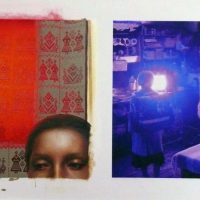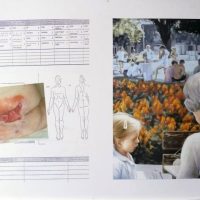They are partly autobiographical, and partly the mixture of imagined elements; the contrast of photo and painting also refers to the fact that what I paint refers to objective reality only to a certain extent. I depicted stories and alternative realities through which I could reflect upon my life, my personality and its possible developments.
At the same time I was interested in the differences of the genres photography and painting, as objective and subjective, and the juxtaposition of a photo and a seemingly photo-like, but rather sight-like painting following Renaissance traditions.
Márta Czene
Márta Czene often expresses her views on feminity through the naked body, into which she condenses her self-image and expresses her secret thoughts indirectly. She doesn’t use her own body in order to create the form, instead she borrows her friends’ bodies, as if inspired by the ancient notion that replaces reality with an ideal object between reality and imagination, which in this case is realized in the ratio and aesthetics of a chosen, existing body.
And this body is not a symbol, not an allegory, not a nude, not an ideal image, and not even a reflection, but a real body, whose model was a young woman of the same age and sensitivity than the artist. With this train of thought connects the natural and shocking picture that may be difficult to interpret, portraying the horror of the bedridden grandmother’s long illness and death and her person reconstructed from memories, which sheds light on the previous statement, that the representation of naked bodies refers to the point where reality enters the imagination.
On the left side of the picture we can see a document about the grandmother’s bed sore, reserved words about an open wound, and under it there is a photo of the real condition, which is actually raw meat. On the right side of the picture there is a family portrait of the grandmother sitting with her back to the five-year-old, perhaps drawing artist, and the entire milieu appears as a stereotype of social-realist happiness, in sharp contrast with the brutal reality on the opposite side.
By placing an excerpt from a story of a family and the diagnostic results next to each other, the changed relationship of art and reality appears, and the brutality of death is opposed to sentimental realism and the symbolic vanitas pictures of art history; eras and ideas clash. The association and extension of the contrast of the pair of paintings confirms and is connected with Eisenstein’s opinion, that the simultaneous 1 image + 1 image = 3 images.
We can find several examples for the savage efforts of contemporary photography and cinematic art to expose reality; this picture reminds me of Kader Attia’s collection which is selected from the archive of injured soldiers’ portraits: photos of distorted faces with undisguised, terrifying fractures caused by bullets and splinters. But there is also an interesting period of Cindy Sherman, when she imitates injuries and wounds on her set photos.
Our inner images are part of the mental machinery that controls fear, feeds on psychic injuries, transforms them into images and lessens their effect. According to Dietmar Kamper this inner image set protects us from too much reality, and materializes experience. (Cf. Focus sequence)
Márta Czene mixes realistic perception and the pictures of moments with these inner images whose projected forms draw upon films. Her efforts lead her to create total realism, vivid pictures either in photo, video or in interactive games, that are the closest to the eclectic, linked method of our perception of everyday reality, and its final interpretation is given by the audience.
Brigitta Muladi

